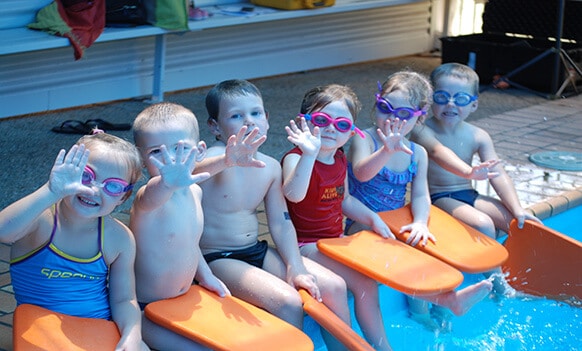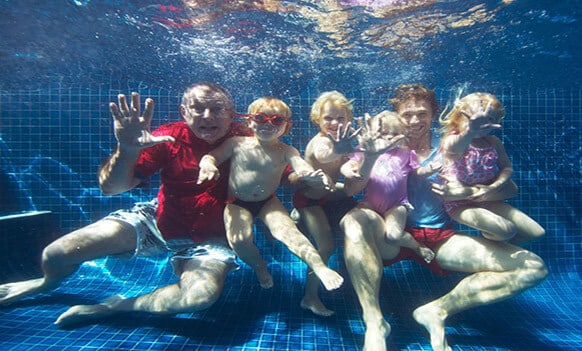
Developing Water Safety Skills
Developing water safety skills and providing water safety education should underpin all formal swimming lessons for kids, within their learn to swim programs. Many water safety components will be taught during the development of foundation swimming skills as we work towards teaching the competitive strokes. For example, floating is the basis of all strokes and is essential to develop good technique but it is also extremely important for self-preservation and survival swimming. Therefore, great swimming programs will not only develop good technique in their swimmers but also teach water safety skills and help to develop safe behaviours and attitudes around the water.
Creating opportunities to educate parents will also be extremely important for swimming teachers and swim schools. This education is vital and easy to achieve during parent and child classes. Here, instructors are in direct contact with the caregiver but as children move into classes without the parents it becomes a little bit more challenging to maintain this direct communication. At this stage, the swim school’s signage around the pool, newsletters, emails, social media updates and contact with deck supervisors and administration staff becomes key.

What we are trying to achieve through swimming lessons:
Hazards Facing Children
There are many potential water hazards for children and these dangers may change as children grow and are exposed to a variety of different environments. Some potential hazards include:
- Backyard swimming pools
- Public pools
- Lakes, rivers and dams
- Beaches and coastal waterways
- Aquatic recreation like fishing and boating
While swimming lessons for kids provide a very controlled environment we can still use this time to help instil safe attitudes and behaviours in children. Get more information from Kids Alive Do the Five.
Swimming Lesson Scenarios
Swimming lessons for kids will give children confidence in the water and expose them to water safety skills such as safe entries and exits, floating and treading water. During classes, we can also create awareness of potential water dangers in a variety of different environments by using games and scenarios that excite their imagination. These activities are great as a warm up or final activity during weekly swimming lessons and are also perfect to incorporate during special water safety weeks.
Remember to teach children the following concepts:
- Read signage
- Swim between the flags
- Stick with a buddy
- Signal for help (Internationally recognised signal is one arm raised/waving above the head)
- Send for help/call emergency services
Water Safety Skills
Is it safe to enter the water? Educate parents and their children to check for, and read signage before entering any water environment. These signs may read things like:
- No swimming
- No lifeguard on duty
- Swimming not recommended at this time
- Submerged rocks
- No diving
- Tropical marine stingers
- Crocodiles inhabit these waters
Once they decide if it’s safe to swim, they then need to understand how to enter and exit the water safely. Learning to check the depth of the water will be very important. During the swimming lesson, it’s very easy to practice the following skills:
- Different ways to enter the water
- Returning to the pools edge
- Monkey around the side of the pool
- Climbing out of the pool
Encourage parents to translate these skills into any new aquatic environment they encounter with their children.
Floating Skills
Floating skills is the basis of all learn to swim but also vital for survival swimming. These skills are great to practice during the warm up for progressive teaching and following a building block approach. However, these floating skills are perfect to revisit when children get fatigued during the class. This is also a perfect activity to achieve maximum practice time as the entire group floats and relaxes together. Learning to feel the water is also an important component for efficiency and speed in swimming. Therefore, simple sculling activities where children learn to sweep their hands outward and inward becomes important for stroke development. Once again sculling is important for survival swimming because this motion will create an uplift force which will support floating skills during survival swimming.
Introducing Deep Water Activities
Once children become comfortable we can introduce deep water activities. Learning to monkey around the side of the pool, edge or rail should be easy to achieve. Remember some children may be nervous with this activity so provide plenty of encouragement and support. Learning to bob underwater and push off the bottom of the pool will be the next step. Again, this is a great warm up activity to establish good breath control and breathing rhythm. You can then progressively move towards floating and treading water before returning to safety at the side of the pool.
Basic Underwater Skills
Underwater skills like removing clothing and untying knots could be extremely useful particularly in communities where boating is a way of life. Swimming teachers should consider the age of children and their swimming ability to determine when these activities are appropriate to include into lessons. Basic underwater skills like picking up rings from the bottom of the pool and swimming through hoops will be the prerequisite skills. Again, these activities are great to do during the warm up, or final activity, of the swimming lesson, or during designated water safety weeks, at the swim school.
Survival Strokes
Sidestroke and survival backstroke are used for recreation, recovery, rescue and survival swimming. These strokes require very little output in comparison to competitive strokes. Many foundation skills for these strokes will be taught during the teaching of freestyle, backstroke and breaststroke. Things like floating, sculling, scissor kick, underwater pull and natural rhythmic breathing will all be introduced during the learn to swim phase for swimmers. Therefore, once children move into stroke development groups these survival strokes will be instinctively and easily mastered. Giving a good visual demonstration of the survival strokes will be the easiest way to teach these concepts. During swimming training, you can use these survival strokes for recovery after sprint sets. You can see that water safety skills can be easily paired with formal swimming teaching to prepare children for safe experiences around water.
Self-preservation is Vital
It’s extremely important that children learn the importance of self-preservation. It’s very easy to get into difficulty while trying to help a mate. For this reason, we should instill the following values in our swimmers:
- Send for help
- Use Reach or Throw rescues first
- If you must approach someone in trouble, approach with a buoyant aid
- Always approach a person in difficulty with extreme caution and adopt a defensive position
